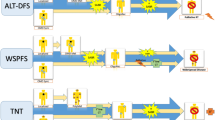Abstract
Background
The optimal radiation field of chemoradiation therapy (CRT) for stage I esophageal squamous cell carcinoma (ESCC) is unknown. This retrospective study compared efficacy and safety of two CRT modalities, involved field irradiation (IFI) and elective nodal irradiation (ENI), when treating patients with clinical stage I (T1bN0M0) ESCC.
Methods
Patients had received 60 Gy CRT concurrently with 5-FU and cisplatin between January 2000 and December 2012. The clinical target volume of IFI was limited to the primary tumor plus a 2-cm craniocaudal margin; that of ENI covered the primary tumor plus the field of regional lymph nodes.
Results
One hundred and ninety-five patients were selected (IFI group, 78; ENI group, 117). The 5-year overall, cause-specific and progression-free survival rates were 90.5%, 91.6% and 77.6% in the IFI group, and 72.5%, 88.3%, 57.9% in the ENI group, respectively. Of recurrent patients (n = 16 in the IF and n = 33 in the ENI groups) after achieving complete remission, 12 (75%) in the IFI group received definitive salvage therapy, 11 (33%) patients did in the ENI group. More patients died of diseases other than esophageal cancer in the ENI group (n = 29, 25%) than in the IFI group (n = 3, 3.8%). Multivariate analysis identified ENI (HR 3.63 [1.78–7.38], p < 0.001), age ≥ 70 (HR 2.65 [1.53–4.58], p < 0.001) and PS = 1 (HR 2.36 [1.33–4.18], p = 0.003) as poor prognostic factors for OS.
Conclusions
IF irradiation would be better than ENI for the patients with stage I ESCC who received definitive chemoradiotherapy.




Similar content being viewed by others
References
Kitagawa Y, Uno T, Oyama T et al (2018) Esophageal cancer practice guidelines 2017 edited by the japan esophageal society: part 1. Esophagus 1:1–24
Kato H, Sato A, Fukuda H et al (2009) A phase II trial of chemoradiotherapy for stage I esophageal squamous cell carcinoma: Japan clinical oncology group study. Jpn J Clin Oncol 39(10):638–643. https://doi.org/10.1093/jjco/hyp069
Kodama M, Kakegawa T (1998) Treatment of superficial cancer of the esophagus: a summary of responses to a questionnaire on superficial cancer of the esophagus in Japan. Surgery 123:432–439
Ito H, Itasaka S, Sakanaka K et al (2017) Long-term complications of definitive chemoradiotherapy for esophageal cancer using the classical method. J Radiat Res 58(1):106–113
Wang X, Miao C, Chen Z et al (2017) Can involved-field irradiation replace elective nodal irradiation in chemoradiotherapy for esophageal cancer? A systematic review and meta-analysis. Oncol Targets Ther 10(5):2087–2095
Akutsu Y, Kato K, Igaki H et al (2016) The prevalence of overall and initial lymph node metastases in clinical T1N0 thoracic esophageal cancer from the results of JCOG0502, a prospective multicenter study. Ann Surg 264(6):1009–1015
Gao XS, Qiao X, Wu F et al (2007) Pathological analysis of clinical target volume margin for radiotherapy in patients with esophageal and gastroesophageal junction carcinoma. Int J Radiat Oncol Biol Phys 67(2):389–396
Japan Esophageal Society (2017) Japanese classification of esophageal cancer, 11th edition: part II and III. Esophagus 14(1):37–65
Minsky BD, Pajak TF, Ginsberg RJ et al (2002) INT0123 (radiation therapy oncology group 94–05) phase III trial of combined-modality therapy for esophageal cancer: high-dose versus standard-dose radiotherapy. J Clin Oncol 20:1167–1174
Kato K, Nakajima TE, Ito Y et al (2013) Phase II study of concurrent chemoradiotherapy at the dose of 50.4 Gy with elective nodal irradiation for stage II–III esophageal carcinoma. Jpn J Clin Oncol 43(6):608–615
Onozawa M, Nihei K, Ishikura S et al (2009) Elective nodal irradiation (ENI) in definitive chemoradiotherapy (CRT) for squamous cell carcinoma of the thoracic esophagus. Radiother Oncol 92:266–269
Kawaguchi Y, Nishiyama K, Miyagi K et al (2011) Patterns of failure associated with involved field radiotherapy in patients with clinical stage I thoracic esophageal cancer. Jpn J Clin Oncol 41(8):1007–1012
Ishikawa H, Sakurai H, Tamaki Y et al (2006) Radiation therapy alone for stage I (UICC T1N0M0) squamous cell carcinoma of the esophagus: indications for surgery or combined chemoradiotherapy. J Gastroenterol Hepatol 21(8):1290–1296
Fukada J, Shigematsu N, Ohashi T et al (2012) Pericardial and pleural effusions after definitive radiotherapy for esophageal cancer. J Radiat Res 53:447–453
Ishikura S, Nihei K, Ohtsu A et al (2003) Long-term toxicity after definitive chemoradiotherapy for squamous cell carcinoma of the thoracic esophagus. J Clin Oncol 21:2697–2702
Mackley HB, Adelstein JS, Reddy CA et al (2008) Choice of radiotherapy planning modality influences toxicity in the treatment of locally advanced esophageal cancer. J Gastrointest Cancer 39(1–4):130–137
Acknowledgements
This study was supported by the National Cancer Center Research and Development Fund (29-A-3). We thank Dr. Nobukazu Hokamura for collecting the data used in this study.
Author information
Authors and Affiliations
Corresponding author
Ethics declarations
Conflict of interest
Ken Kato received honoraria from Eli Lilly and Beigene; and research funding from ONO, MSD, Merck Serono and Shionogi Co and Ltd. Narikazu Boku received honoraria from Taiho, Chugai, Eli Lilly, Ono and BMS; and research funding from Taiho and Ono. YN, HS, SI, YN, AT, TU, YI and JI report no potential conflicts of interest.
Additional information
Publisher's Note
Springer Nature remains neutral with regard to jurisdictional claims in published maps and institutional affiliations.
Electronic supplementary material
Below is the link to the electronic supplementary material.
About this article
Cite this article
Nakatani, Y., Kato, K., Shoji, H. et al. Comparison of involved field radiotherapy and elective nodal irradiation in combination with concurrent chemotherapy for T1bN0M0 esophageal cancer. Int J Clin Oncol 25, 1098–1104 (2020). https://doi.org/10.1007/s10147-020-01652-7
Received:
Accepted:
Published:
Issue Date:
DOI: https://doi.org/10.1007/s10147-020-01652-7



